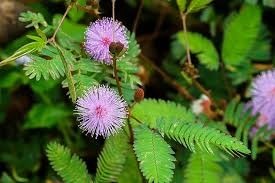Introduction
Mimosa pudica L. is a subshrub of America and Australia, also found in India with thorns and they have grey green sensitive soft leaflets that folds and droop at night or when touched and cooled. These unique binding movements have earned it a status of ‘curiosity plant’.
It majorly possesses antibacterial, antifertility, anticonvulsant, antivenom, aphrodisiac and antidepressant, various other pharmacological activities. This herbs has been used traditionally for numbers of years, in the treatment of sinus, piles, dysentery, urogenital disorders and applied on wounds.
Common names of Mimosa pudica l
- Laajvanti, Touch me not
- Chhui-mui, Ayurveda – Lajjalu
- Namaskari, Samangaa
- Samokchini
- Shamipatraa
- Siddha-Thottal Chinungi.
Vernacular names of Mimosa pudica l
- Sanskrit – Lajja
- English – Sensitive plant
- Hindi – Laajvanti and Chhui-mui
- Bengali – Lajjabati
- Telugu – Attapatti and Peddanidrakanni
- Tamil – Tottaaladi and Thottalchnungi
- Kannada – Lajja, Nachika and Mudugu-davare
- Malayalam – Tintarmani
- Habitat: open-spaces, cultivated land, waste area, roadside.
- Family: Mimosaceae

Antimicrobial properties of Mimosa pudica l
- Antimicrobial activity of the extracts M.pudica was studied against gram positive and gram-negative bacteria in chloroform, ethyl acetate, petroleum ether, methanol using the zone of inhibition.
- To check the antibacterial efficacy of this plant extracts both agar well diffusion method and agar disc diffusion method were used.
- The microbial strains used in the test were: Escherichia coli, Proteus vulgaris, Salmonella typhi, Salmonella paratyphi A, Salmonella paratyphi B, Shigella flexneri, Staphylococcus albus, Staphylococcus aureus, Klebsiella pneumonia, and Pseudomonas aeruginosa.
- The minimum inhibitory concentration (MIC) of the methanolic extract of the plant was determined by agar well diffusion method.
- The result of this assay was revealed that the extracts of said plants possess good antimicrobial activity between the range of 7-18mm against the pathogen used for screening.
Antifungal activity of Mimosa pudica l
The methanolic extract and aqueous extract of the said plant in the range of 100, 200, and 500 mg were tested against different fungal pathogens, Aspergillus fumigates for their antifungal activity. It was determined by a well diffusion assay.
Antiviral properties of Mimosa pudica l
M.pudica exhibited antimicrobial activity against yellow fever, chikungunya virus (CHIKV), and enterovirus 71.
Pharmacological activity of Mimosa pudica l
Wound healing activity, Anticonvulsant action, Antifertility activity, Antiviral properties, Antidepressant action, Diuretic effect, Antihepatotoxic, antioxidant potential, and Antivenom activity.
Antivenom activity of Mimosa pudica l
- Root extracts of the plant M.pudica is widely used as the antivenom because it dependently inhibits the protease and hyaluronidase activities of Indian snakes which includes (Naja naja, Vipera russelii, and Echis carinatus) venom.
- Along with this, dried roots of the same plant in the form aqueous and alcoholic extracts were tested for the inhibitory activity of Indian snake Naja kaouthia venom such as lethality, toxic enzymes and myotoxicity.
- The aqueous extract has dependently more inhibitory activity in comparison to the alcoholic extracts. These present findings significantly suggest that an aqueous extract of the plant M.pudica root which inhibits the activity of the venom of cobra.
Antifertility activity of Mimosa pudica l
- In India it is one of the folk medicinal plant and most commonly used as antifertility agent in some places. Air-dried roots of M. pudica were extracted using methanol.
- It was then administered orally to Swiss albino mice for 21 consecutive days. Estrous cycle, reproductive hormones (LH, FSH, prolactin, estradiol, and progesterone) and number of litters produced were studied in both control and extract administered groups by using standard methods.
- TLC and qualitative methods are used for Phytochemical studies of the methanolic root extract. In albino mice, it has antifertility effect as it extend the estrous cycle and also disturbs the secretions of the gonadotrophin hormone.
Uses of Mimosa pudica l

Classical/traditional uses
- Charak and Sushruta prescribed a decoction, with Samangaa as an awfully important ingredient in hemothermia, protracted dysentery, piles, and diarrhea. It was included in an ointment, and the herb was applied over piles, and wounds, ulcers.
- During 16th century, Lajjalu was a preferred herb for treating piles and diseases of female genital tract. Samangaadi churna is obtainable over the counter, prescribed internally in bleeding piles.
Therapeutic uses
- Raktapita, sopha, daha, svasa, atisara, yonirogavrana, and kustha. The plant is sheetala (Sheetaveerya), Kashaya, tikta; subdues deranged kapha and pitta beneficial in gynecological disorders, hemorrhagic diseases, diarrhea, and.
Leaves
- The leaves together with leaves from other medicinal plants are utilized in treating hemorrhoids and urinary infections. The juice is utilized in sinus, sores, piles, and fistula, paste is applied to glandular swellings, and hydrocele.
Roots
- Decoction is efficacious in gravel and other urinary complaints. Treats dysentery, fever, syphilis, leprosy, stomach worms, veneral diseases, sting, insomnia, nervousness, and piles.
References and Sources:
- https://www.scribd.com/document/236217281/Mimosa-Pudica
- https://www.researchgate.net/publication/289494930_Antibacterial_activities_of_the_extracts_of_Mimosa_pudica_L_An_in-vitro_study
- http://www.pharmaresearchlibrary.com/wp-content/uploads/2019/03/JPBR3476.pdf

